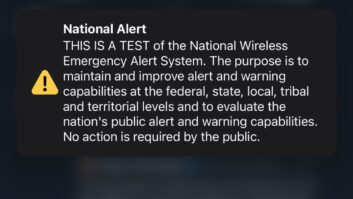The message that participation in national EAS tests is a priority has been heard loud and clear by most EAS participants, particularly by radio station operators.
It’s also clear that more participants are committed to sending the alert in both the English and Spanish languages.
It was back in October that the Federal Emergency Management Agency conducted another nationwide test of the Emergency Alert System and the first ever nationwide Wireless Emergency Alert, which was delivered to mobile devices.
[Read: Prepping for Not One But Two National Tests]
At 2:18 p.m. Eastern on Oct. 3, FEMA sent a WEA test message to WEA-capable wireless devices throughout the United States and territories; immediately following, FEMA conducted a live test of the EAS to EAS participants. That message was transmitted in English and Spanish and included both a text message and audio.
All participating mobile service providers were required to participate in the WEA portion of the test, while all EAS participants — including thousands of radio stations, TV stations and cable providers —were required to participate in the EAS piece.
According to results recently released by the FCC, 95.5% of EAS participants successfully received the National Periodic Test code used for the test, while 91.8% successfully retransmitted the test. Those numbers are consistent with the participation levels observed in the 2017 nationwide EAS test.
Of the 13,465 radio broadcasters who were 2018 test participants, 96.3% of those successfully received the test. Of those, 93.5% went on to successfully retransmit the alert. Both of those numbers are down about 1 percentage point from the receive/transmit levels in 2017.
There were slight improvements in other areas. Nearly 91% of test participants who filed their Form Three (which offers detailed data on what happened after the test) reported no complications in receiving the test, up from 89% in 2017. A total of 89% reported no complications in retransmitting the test, a figure up slightly from 88% in 2017.
This year, a significantly larger number of test participants reported to have retransmitted the Spanish language version of the alert. In 2018, 756 test participants retransmitted the alert as it was generated through the IPAWS system, up from only 207 participants in 2017.
Even though this was the first nationwide test of the WEA system, the bureau determined that this test did successfully demonstrate that a WEA can be delivered nationwide, although there were some reported cases of inefficient reception.
Through local emergency management agencies, news reports and feedback from the FCC’s Public Safety Support Center (PSSC), the FCC and FEMA found that approximately 72% of respondents reported receiving the WEA test message. Of the 361 responses that were filed voluntarily with the PSSC, approximately 61% reported no problems in receiving a WEA. The remaining 39% either did not receive a WEA or received one that had issues, such as receiving multiple messages or having problems with the tone or vibration cadence.
Mixed reports came from news agencies nationwide.
In some cases, participating wireless providers did not successfully deliver the WEA test message at all, while other users indicated that WEA receipt was uneven — some individuals received the alert while others in the same region did not. One reporter revealed that, in the case of his two phones, one received the alert twice, while the other did not receive the message at all.
The FCC and FEMA said in a joint release that they will continue to analyze the results and release more detailed findings when available.










